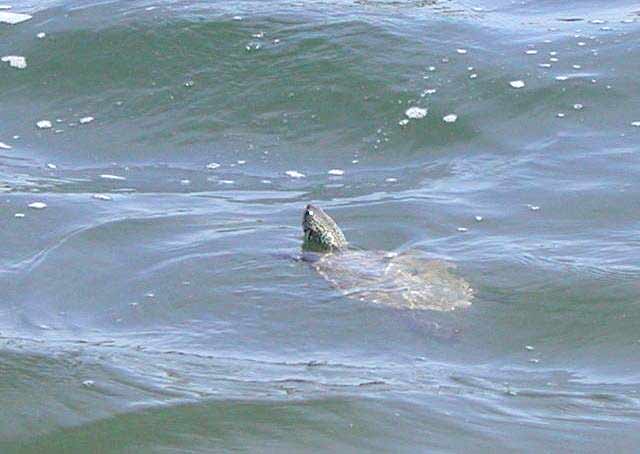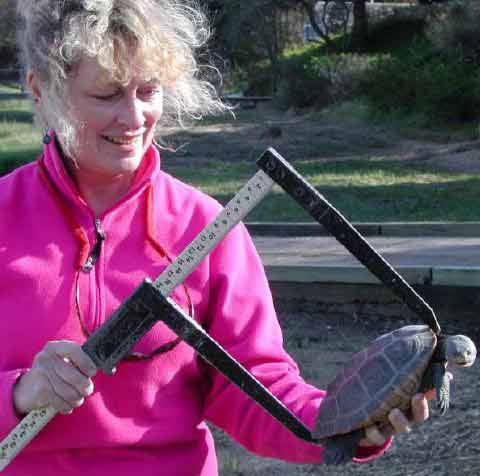Cinco de Mayo — Chipman’s Cove Panorama — 5 May 2002Cinco de Mayo on the Outer Cape dawned in brilliant sunshine with a moderate bayside breeze. Temperatures rose to the mid-60s and terrapins finally emerged. With an early afternoon low tide, I launched my kayak off the town pier to observe turtles as they were flushed out of Duck Creek. I counted a few heads as they bobbed around the mud flats, but the water proved too murky for captures. Frustrated after two hours of hide and seek, with the hiders winning every encounter, I paddled around the pier to survey Chipman’s Cove. 
The cove supports a large population of terrapins who use this rich embayment for foraging. With no nesting sites abutting the cove, female turtles shuttle back and forth between nesting runs to take in added calories. Largest concentrations of terrapins are usually found in the cove from June through July. See Chipman’s Cove in panoramic view (68 Kb). As I rounded the sandbar, I spotted a turtle basking on the surface. She dove for the bottom — now only three feet below with dead low tide. Hugging the cove floor, she zigzagged away from the kayak but unfortunately left a mucky trail akin to a jet contrail as she clawed through the mud.
In the next 30 minutes three more turtles were netted. These critters never surfaced but lay on the bottom, letting the filtered sunlight bake their carapaces. All the captures were females. Number 1198, a 10-year-old, and Terrapin 1199, a 15-year-old, were first time captures. Terrapin 1117, another 10-year-old, had last been observed on 13 June 2001 (see Mud Wrestling; use back button to return to this page) as she basked on the mud flats of Duck Creek about a quarter mile to the northeast. In the intervening 11 months, #1117 has grown quite a bit. She increased her weight from 897 to 1034 grams and stretched another 8 millimeters in shell length. Turtle 1137, a 12-year-old, proved a very interesting recapture. On 18 June 2001, she was nesting on Indian Neck off Blackfish Creek about 1.5 nautical miles to the south. She had gained 54 grams and grew 2 millimeters since then.
On the other side of the Cape in Pleasant Bay, Elizabeth Hogan and her team paddled kayaks into Henson’s and Frostfish Coves in search of terrapins from that unique population. They, too, were frustrated by conditions. West winds had mucked visibility and few turtles were observed.
Terrapin 625 was another recapture. This population appears to have collapsed so dramatically that nearly every turtle is a recapture, even with an interval of three years between samplings. Very few recruits have been seen, and our concern for the viability of the Pleasant Bay terrapin population has intensified. Thanks to volunteers such as Ms. Hogan and her team, we should acquire sufficient research data this year to support a major conservation initiative to save this vulnerable population. | |||||||||



